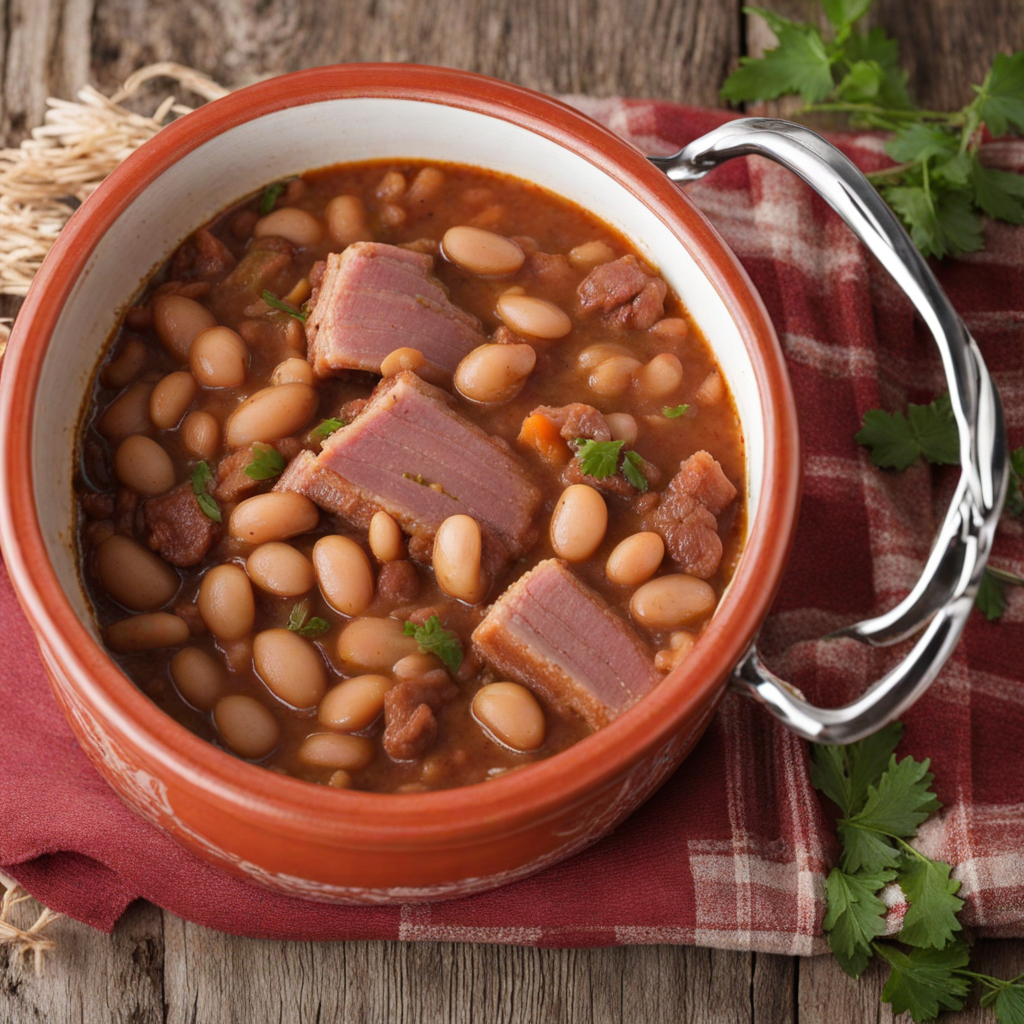Bean Stew with Smoked Pork
Bean Stew with Smoked Pork, or "Ciorbă de fasole cu afumătură," is a hearty traditional Romanian dish that exemplifies the rustic flavors of the country's culinary heritage. The foundation of this stew is a medley of plump, tender beans, often combined with a robust smoked pork, which infuses the dish with a deep, savory aroma. The beans are typically simmered to perfection, allowing them to absorb the smoky essence of the meat, while also creating a creamy texture that comforts the soul. This dish is usually seasoned with a blend of herbs such as thyme and bay leaves, which enhance the earthy flavors and create a well-rounded taste that is both satisfying and warming. As the stew cooks, the aromatic mix of onions, carrots, and occasionally bell peppers adds a natural sweetness, balancing the smokiness of the pork. The addition of tomato paste or fresh tomatoes introduces a slight acidity that brightens the dish, making each spoonful a delightful experience. Traditionally served in rustic bowls, the vibrant colors of the stew are inviting, often garnished with fresh parsley or dill for an extra pop of flavor. Pairing this dish with a slice of crusty bread or polenta enhances the enjoyment, as you can soak up the rich broth. This comforting stew is a staple in Romanian households, particularly during colder months, and is often enjoyed during festive occasions or family gatherings. The combination of ingredients not only showcases the country's agricultural bounty but also highlights the age-old techniques of preserving meats through smoking. Each bite of Bean Stew with Smoked Pork is a glimpse into Romanian culinary traditions, evoking a sense of warmth and community that is at the heart of this beloved dish.
How It Became This Dish
The Rich History of Iahnie de Fasole cu Ciolan #### Origins and Cultural Roots Iahnie de fasole cu ciolan, a traditional Romanian dish, is a flavorful bean stew that features a hearty addition of smoked pork hock (ciolan). To understand its origins, one must delve into the rich tapestry of Romanian culinary traditions, which are deeply rooted in the country's agricultural practices and historical influences. Beans, particularly white beans, have been a staple in Romanian households for centuries. The cultivation of beans dates back to ancient times, often associated with the agricultural lifestyles of the Dacians, the pre-Roman inhabitants of the region. As a legume that thrives in various climates, beans were not only a nourishing food source but also an integral part of the Romanian peasant diet, symbolizing sustenance and simplicity. The use of smoked pork hock in the dish reflects the significance of pork in Romanian cuisine, which has its roots in the agricultural practice of raising pigs. In rural communities, it was common for families to raise a pig for food, utilizing every part of the animal to minimize waste. The practice of smoking meats dates back to ancient preservation techniques, ensuring that meat could be stored for longer periods. This traditional method not only adds flavor but also connects the dish to a broader historical context of resourcefulness and sustainability. #### Cultural Significance Iahnie de fasole cu ciolan is more than just a dish; it embodies the spirit of Romanian hospitality and communal dining. It is often served during festive occasions, family gatherings, and traditional celebrations, such as Christmas and Easter, where it holds a place of honor on the table. The preparation of this dish is frequently a communal effort, with family members coming together to cook and enjoy it, reinforcing bonds and sharing stories. In Romanian culture, food is intrinsically linked to identity, history, and social connection. Iahnie de fasole cu ciolan encompasses these elements, representing the heritage of rural life and the importance of traditional cooking methods. The dish is commonly associated with the winter season, offering warmth and comfort during cold months, and its preparation often coincides with the harvest season, showcasing the bounty of local agriculture. Moreover, the dish is a testament to the adaptability of Romanian cuisine. While it remains rooted in tradition, variations can be found across different regions, reflecting local ingredients and culinary practices. For example, some versions may incorporate different types of beans or additional vegetables, showcasing the flexibility and creativity inherent in Romanian cooking. #### Development Over Time The evolution of Iahnie de fasole cu ciolan mirrors the broader changes in Romanian society and culinary practices. During the 19th century, as Romania began to modernize and urbanize, traditional dishes like iahnie started to gain prominence beyond rural areas. The dish became a symbol of national identity, especially during the interwar period, when culinary nationalism flourished, and traditional recipes were celebrated as part of Romania's cultural heritage. In the 20th century, particularly during the Communist era, food became a means of expressing resilience and maintaining cultural identity amidst political and economic challenges. The availability of ingredients fluctuated, and home cooks often had to adapt recipes based on what was accessible. Despite these restrictions, iahnie de fasole cu ciolan remained a beloved staple, showcasing the resourcefulness of Romanian families. As Romania transitioned to a market-oriented economy in the 1990s, there was a renewed interest in traditional foods and culinary heritage. Chefs and food enthusiasts began to rediscover and celebrate authentic Romanian recipes, and restaurants started to feature traditional dishes prominently on their menus. Iahnie de fasole cu ciolan enjoyed a renaissance, appealing to both locals and tourists seeking an authentic taste of Romania. The rise of food tourism also contributed to the dish's popularity. Travelers eager to explore Romanian culture through its cuisine often seek out traditional meals, with iahnie de fasole cu ciolan serving as a quintessential example of the country's culinary offerings. Food festivals celebrating Romanian gastronomy further solidified its status, showcasing the dish as a symbol of national pride. #### Contemporary Interpretations In modern times, while the traditional recipe remains cherished, chefs and home cooks have begun experimenting with new twists on the classic dish. Some incorporate a variety of beans, such as kidney or black beans, or add spices and herbs to elevate the flavor profile. Others may experiment with vegetarian versions, replacing the pork hock with smoked paprika or liquid smoke to achieve a similar depth of flavor without meat. Moreover, the accessibility of international ingredients has led to fusion interpretations, blending Romanian culinary traditions with global influences. However, despite these modern adaptations, the heart of iahnie de fasole cu ciolan remains unchanged—a comforting, hearty stew that tells the story of its origins and the people who have cherished it throughout generations. #### Conclusion Iahnie de fasole cu ciolan is not merely a dish; it is a cultural artifact that encapsulates the history, traditions, and communal spirit of Romania. From its humble origins as a staple of rural diets to its modern-day recognition as a symbol of national identity, this bean stew has undergone an evolution that reflects the changes in Romanian society. Today, as Romania continues to embrace its culinary heritage while exploring new gastronomic landscapes, iahnie de fasole cu ciolan stands as a testament to the resilience and creativity of Romanian cuisine. Each bowl served is a celebration of history, community, and the enduring love of food that transcends generations, inviting both locals and visitors to partake in a rich cultural experience that is as nourishing to the soul as it is to the body.
You may like
Discover local flavors from Romania







